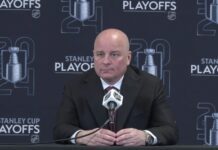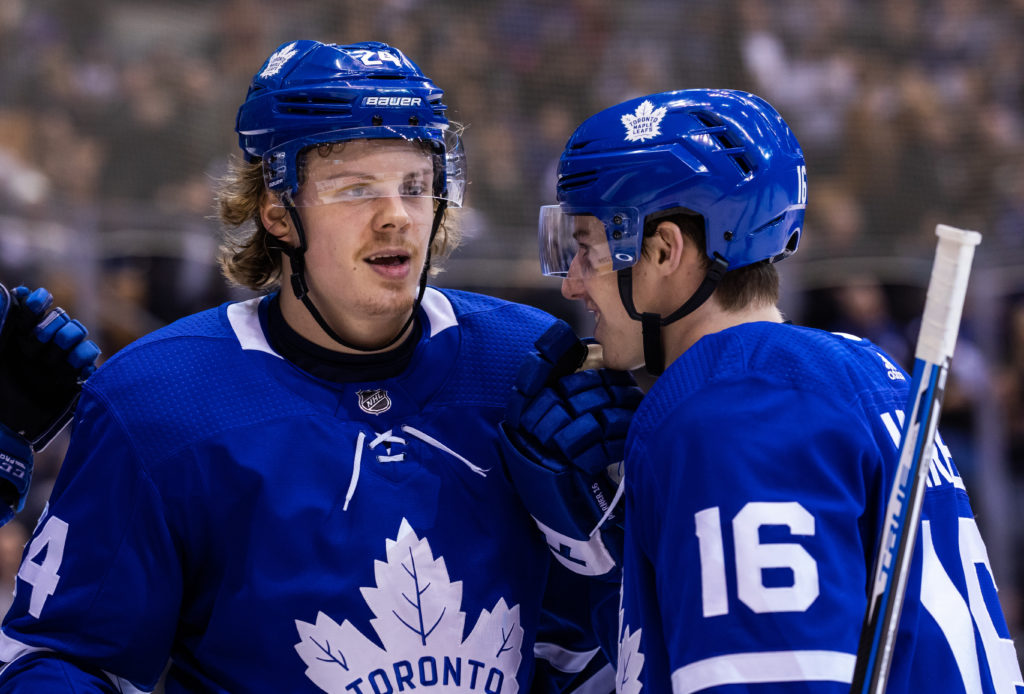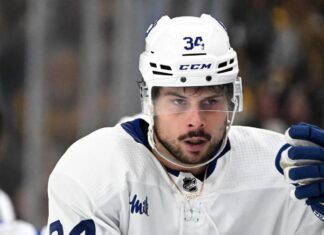Entering the offseason, the Toronto Maple Leafs have a number of needs and questions in need of addressing.
The needs are the priorities, and for once, they don’t involve a player negotiation. The questions are more of an internal exercise to help shape the roster for the start of next season.
When it comes to needs, they generally consist of the same things going on a few years now: improve the defense with legitimate defenders who can be trusted to handle tough minutes (at least one, ideally two), improve the bottom six, and add some center depth (not sure Alex Kerfoot – Pierre Engvall is the one-two punch you want on that side of the roster).
The questions, though, are relatively new. Do they still trust Frederik Andersen to be the guy? Can they round out their roster properly when they have a number of high salary players? Are they going to move William Nylander to the center (at least) semi-regularly given what happened in the playoffs this year? Is Zach Hyman a left winger or a right winger? Is Alex Kerfoot a center or winger? What are they going to do with Travis Dermott? (If they keep him, that would seemingly give them five defensemen, and I’m not sure this group is good enough to only make one acquisition and then call it a day.)
In trading Kasperi Kapanen, as well as Pontus Aberg and Jesper Lindgren for a first-round draft pick (15th overall), Evan Rodrigues, David Warsofsky, and Filip Hallander, the Leafs address none of those things directly. In fact, trading Kapanen currently makes what was already a fairly mediocre bottom-six even worse.
Kyle Dubas knows that, and he admitted as much with the money line in his media availability: “The key is that we need to gain some flexibility or greater flexibility than what we have.” With the salary cap, they can barely afford to keep their pending restricted free agents, let alone improve the team.
In that regard, moving Kapanen made sense. He couldn’t play left wing when they moved him there in the top six – there were a number of attempts at this, too – and he was never going to beat out Mitch Marner or William Nylander on the right side — ever. He was stuck as a third line right winger.
Kapanen’s goal scoring was also down this season, and he was healthy scratched because he slept in and missed practice. He also wasn’t exactly set up for success this season, bouncing around the roster to the point where the player he played the most with at even strength was Tyson Barrie and the second highest was Cody Ceci. The two forwards he played the most with were Kerfoot and Jason Spezza. That’s not great.
Subjectively, I liked what he brought to the table in terms of his speed and (flashes of) his knack for scoring big goals, and he was one of the only forwards on the team with some jam to his game – including a nice stretch of it while the Leafs were in their playoff race in February.
Kapanen also hasn’t even played three full seasons in the league. There is room for his game and off-ice habits to mature. Ultimately, I think he’s a nice third-line forward who can move up on occasion, but from the Leafs‘ point of view, he was making a lot of money for that role at $3.2 million. Plus, he had trade value.
While Kapanen is a player of concrete value moved off the roster, the Leafs acquisition was really to open up opportunity more than bring back anything of immediate value. Warsofsky is more or less an AHL defenseman and Rodrigues has a qualifying offer of $2 million that the Leafs will surely decline while attempting to bring him back at a reduced number. He’s also 27 and has played over 50 games in a season just once. He has shown to be serviceable depth, but it would be hard to ask for much more.
Hallander was expected to return to Sweden for the following season and reports indicate it’s unlikely he crosses to North America to play in the AHL. Perhaps that changes with Toronto’s setup, but as of now, he’s a player not totally under their control, although he does have some real potential.
Even the 15th overall pick (yes, I know, it’s a heralded draft), while a great asset, is a mystery box. The Leafs drafted Timothy Liljegren in 2017 at 17th overall – I’m not sure he will or should make the team next season. Since 2015, the following players have been drafted at 15th overall: Zachary Senyshyn, Luke Kunin, Erik Brannstrom, Grigori Denisenko, and Cole Caufield. It is not a slam-dunk spot.
It is entirely possible they traded a player who should be a 10+ year NHLer for essentially nothing. It is also possible they hit a home run. They’ll surely use the cap space to do something, but it could be as simple as freeing up money to bring back Travis Dermott and Ilya Mikheyev – two players Dubas did mention when discussing the trade and money opening up. That is not a bad thing, but it’s not a net positive for making the roster better next season. Losing Kapanen is certainly not addition by subtraction.
In retrospect, we probably should have seen this type of trade coming (i.e. the Leafs clear cap space and bring in some futures). This would have been their second year in a row without a first-round pick and they need to find cheap talent while they pay their top guns big dollars. The draft is the best way to do that.
You can argue it could have been someone else traded away first, but the Leafs would likely say Kapanen had the most valuable of their mid-level players. And mid-level players like Kapanen are exactly the types that are squeezed off your roster when you have a handful of players making huge dollars against your cap.
If you are looking to clear money off your books, this type of return for a Kapanen-level player is good value. Now we wait to see what they do as a follow-up to actually improve the roster.


![Sheldon Keefe Post Game, Leafs 3 vs. Bruins 2: “I loved [the Matthews] line, and I loved a lot about our game all the way through the lineup” Sheldon Keefe, Toronto Maple Leafs post game](https://mapleleafshotstove.com/wp-content/uploads/2024/04/keefe-pg-game-1-218x150.jpg)


![Jim Montgomery on adjustments for Game 2 vs. the Maple Leafs: “We need to spend more time in the offensive zone… We didn’t do a good job offensively at five-on-five [in Game 1]” Jim Montgomery, Boston Bruins practice](https://mapleleafshotstove.com/wp-content/uploads/2024/04/jim-montgomery-bruins-218x150.jpg)






















![Sheldon Keefe Post Game, Leafs 3 vs. Bruins 2: “I loved [the Matthews] line, and I loved a lot about our game all the way through the lineup” Sheldon Keefe, Toronto Maple Leafs post game](https://mapleleafshotstove.com/wp-content/uploads/2024/04/keefe-pg-game-1-100x70.jpg)




![Jim Montgomery on adjustments for Game 2 vs. the Maple Leafs: “We need to spend more time in the offensive zone… We didn’t do a good job offensively at five-on-five [in Game 1]” Jim Montgomery, Boston Bruins practice](https://mapleleafshotstove.com/wp-content/uploads/2024/04/jim-montgomery-bruins-100x70.jpg)

